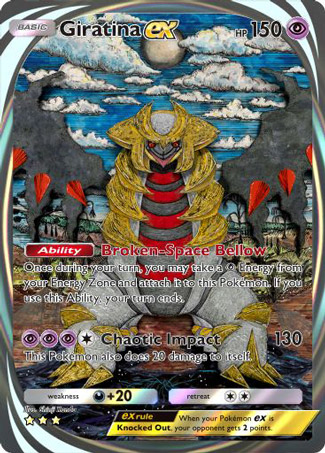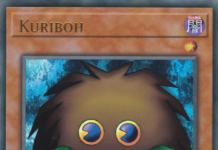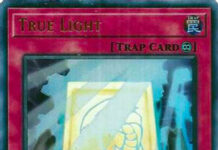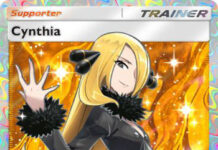
Giratina ex – Shining Revelry
Date Reviewed: April 4, 2025
Ratings Summary:
Ratings are based on a 1 to 5 scale. 1 is horrible. 3 is average. 5 is great.
Reviews Below:

Otaku
Edit: My apologies to the handful of people who got to see a blank review posted!
The second best card of Shining Revelry is Giratina ex (A2b 035, 083, 096)! It’s a (P) Type, Basic Pokémon ex with 150 HP, (D) Weakness, (C)(C) Retreat Cost, the Ability “Broken-Space Bellow”, and the attack “Chaotic Impact”. Broken-Space Bellow lets you take a (P) Energy from your Energy Zone, and attach it to Giratina ex, but it then ends your turn. Chaotic Impact costs (P)(P)(P)(C) and allows Giratina ex to do 130 damage to your opponent’s Active, but also 20 damage to itself. Giratina ex is available at the ♦♦♦♦, ★★, and ★★★ rarities.
Being a Basic remains the best. No additional cards are required to hit the field, there’s no waiting to evolve, and anti-Basic effects1 see little to no play. When it comes to Basic support, Poké Ball (P-A 005) is a staple, and Shaymin (A2a 069, 081) has been proven.2 As for being a Pokémon ex, it’s likely why Giratina ex enjoys the stats and effects it has, because it means giving up an extra Prize when KO’d, and taking extra damage from four cards,3 most notably Red (A2b 071, 090).
The (P) Type came out strong in the early days of Pocket, then seemed to go extinct after the introduction of Space-Time Smackdown. The Psychic Type has two pieces of support. Gardevoir (A1 132) provides reusable Energy acceleration of (P) Energy, for your Active (P) Pokémon. Mythical Slab (A1a 065) straddles the line between search and draw, as it lets you look at the top card of your deck, then add it to your hand if it is a (P) Pokémon. Otherwise, the revealed card is sent to the bottom of your deck.
If we’re expand support to include “Useful (P) Pokémon”, we can add in “baby” Giratina (A2 078, 167), Giratina ex (…yes, today’s card!), Jynx (A1 127), Mew ex (A1a 032, 077, 083, 086), Mewtwo ex (A1 129, 262, 282, 286; P-A 050), Sigilyph (A1a 033) and even more that never quite proved themselves, often because they were overshadowed by the (P) Pokémon I already listed! Where the Type falls short is Weakness.
When it comes to exploiting Weakness, only some (F) Types are (P) Weak. Competitive (F) Types with (P) Weakness go all the way back to Genetic Apex, but it wasn’t until Gallade ex (A2 095, 185, 200) that we got a large, competitive (P) Weak (F) Type for the Weakness to actually matter. The real problem, though, is all the competitive (P) Types I listed are (D) Weak. The utter dominance of Darkrai ex (A2 110, 187, 202; P-A 042) remains a big problem, bringing us back to Giratina ex.
Giratina ex has 150 HP. This is good in general, and great for a Basic Pokémon ex. However, it isn’t as big as it looks. I don’t just mean that power creep is already kicking in, with more decks capable of doling out 150 in a single attack, whether through combos or raw brute force. I don’t just mean the dangerous (D) Weakness I already addressed. As Giratina ex’s own attack has recoil, you’ll need to be cautious to avoid blundering into pseudo-OHKO range.
I’ve been glossing over it too much, so it’s time to go into detail about Retreat Costs. While Retreat Costs follow a linear progression from zero (free) to (C)(C)(C)(C), each step’s competitive value does not. Lower is definitely better, with four being the worst, almost as bad as just saying “this Pokémon cannot retreat.” Free is also obviously the best, but because of cards like Leaf (A1a 068, 082), Shaymin (A2a 069, 081), and X Speed (P-A 002), (C) is much better than (C)(C).
(C)(C) is still good for a Retreat Cost. It’ll definitely set you back when you have to pay it in full, but if you know you’ll likely to need to retreat something with that retreat cost, Leaf is there. Yes, she eats up a deck slot and your Supporter for the turn, and not every deck can spare that. The decks that can, or even must, include Leaf, know how much better a Retreat Cost of (C)(C) is than something higher.
Because (C)(C)(C) means still discarding an Energy, even with Leaf, while (C)(C)(C)(C) means discarding two Energy with Leaf. Thus both the higher scores mean an already crowded deck reads them as “This Pokémon usually cannot retreat.” Which is my long-winded way of stating that Giratina ex’s mathematically average Retreat Cost of (C)(C) is actually “good”. Due to Giratina ex’s Ability, arguably even very good.
Broken-Space Bellow is one of those Abilities I see and, at first, think “that’s so good!”. Then I rethink and go “Wait, maybe it’s bait4”? In the end, I had enough time to confirm that the former was the correct evaluation. Whether we’re talking Pocket or the full Pokémon TCG, Energy acceleration can be game-breaking. However, it can also be a waste of time when the Energy acceleration in question isn’t worth the cost, or comes with too many restrictions or stipulations.
Broken-Space Bellow only lets you attach (P) Energy. It only lets you attach that Energy to the Giratina ex that used the Ability. These restrictions were not the cause of my concern. It was that using Broken-Space ends your turn. That’s a steep cost, until you look at the metagame. Yes, it is a deal-breaker for decks that need to attack ASAP, whether to do damage or aid in setting up. Then I remembered all the decks that don’t use or need their early game attacks.
If your deck already hides behind something like an opening Druddigon (A1a 056), you lose nothing for ending your turn via Broken-Space Bellow. This Ability does not bend any game rules other than by giving you an extra Energy attachment. No using it during your opponent’s turn, after attacking, etc. It doesn’t affect or care about the Energy your Energy Zone normally produces, either.
Chaotic Impact may be slightly overpriced. In a vacuum, 130 damage for four Energy would good, but not great. Especially as three of those four Energy need to be (P) and there’s 20 points of recoil damage. If this sounds overly critical, first image Chaotic Impact on something without 150 HP and/or without Broken-Space Bellow. Next, imagine if Chaotic Impact had more (C) Energy requirements. Unless we’re running Giratina ex on-Type, it’ll take at least three turns to prep.
Fortunately, the total package makes this work, as tournament results for the last few weeks have demonstrated. Giratina ex decks are both among the most played and the most successful since Shining Revelry released. Nor was it a recent rise to glory. It did so well that I felt I had to make a last-minute revision to the countdown. Arguably, I under corrected, and Giratina ex ought to have been #1, and I only bumped it up to #2, from #3. All other things being equal, I value general usage over deck-specific. Giratina ex isn’t locked in to a single Type, but won’t perform well in many strategies.
Using Giratina ex well is similar to using Magnezone (A2 053) well. Not quite the same, as we’re talking a Basic Pokémon ex versus a Stage 2 single-point Pokémon, and (P) Typing versus (L). Thanks to the Ability on Magneton (A1 098), you can run a wide variety of partners with Magnezone. The partners do their thing, while Magneton builds Energy so it can eventually evolve into Magnezone. A strong backup (or even focal) attacker that freed up Energy attachments to go elsewhere. Even while the Magnezone/partner deck constantly attacks.
We already have many notable Giratina ex decks. It really is like the early days of Magnezone’s ascendance. Something these decks have in common are combos to help Chaotic Impact hit the important 150 and 170 damage points. The former means one-shotting fellow Basic Pokémon ex, including opposing (and uninjured) Giratina ex. The latter deals with all but the largest opposing Pokémon ex… and some of these decks can handle even those as well! Another common site is healing, to help managed self-damage.
The best partner for Giratina ex might be it’s biggest antagonist, Darkrai ex! Besides the general potency of both cards, Darkrai ex’s Ability allows it to do damage without actually attacking, at the same time you build it up (preferably on your Bench). Giratina ex partners nicely, building itself up while nothing attacks. Some hide behind a meatshield like Druddigon, while others just deal with the damage accumulating on whichever of the two is Active.
Another great partner is Mewtwo ex. Yes, Psychic is back! The successful lists I saw did not bother supporting the two with Gardevoir or Mythical Slab. You end up with room for many Trainers, and though you can ready Giratina ex a little faster by using manual Energy attachments on it (as opposed to just its Ability), readying two attackers at once might be the preferred strategy. Among Trainer tricks, there’s also Dawn (A2 154, 194). This is good for surprise attacks, especially from Mewtwo ex.
There are more decks people are experimenting with, but I’ll hold off on those as they’re still relatively new (or else, underplayed). If you check the link I listed earlier, you can see Pokémon Zone’s coverage of two of them, however. A Magnezone variant and a Greninja (A1 089, P-A 019) one. Yes, as two separate decks, not together. The former doubles down hiding while building Benched threats. The latter gives you that amazing “hit anything” damaging Ability. Both hide behind Druddigon while they can.
Rating: 4/5
Giratina ex is an amazing card, so that four-out-of-five is me being conservative in my estimate. That being said, it has chinks in its metaphorical armor. Recoil damage shouldn’t be forgotten, nor should (D) Weakness. Even having a “slow” start can be an issue against highly aggressive decks, or those with the right kind of setup. I’ve been running Darkrai ex/Greninja lately; “Water Shuriken” => Cyrus (A2 150, 190) => “Nightmare Aura” => “Dark Prism” has earned many wins…
…but that might be the worst case scenario for Giratina ex decks. It’s a great card, well worth experimenting with if you have the time and desire, but also well worth acquiring and using even if you prefer to just use what already is known to work. Because work it does!
1Pokémon Flute (A1a 064) and Victreebel (A1 020).
2Celestic Town Elder (A2a 073, 088) and Combee (A2 017) are additional pieces of Basic support, but like anti-Basic effects, have seen little to no competitive success.
3Meowscarada (A2b 007, 073), Sudowoodo (A2 036, 079), and Tauros (A1a 060) each have a different attack with an effect that states the attack does more when used against Pokémon ex. All have seen at least some competitive success in their own right.
4A reference to the infamous Magic: The Gathering psychographic profiles. If I refer to a card as “bait”, it likely has something to appeal to one or more of those profiles. Usually this is a derogatory term.
We would love more volunteers to help us with our Card of the Day reviews. If you want to share your ideas on cards with other fans, feel free to drop us an email. We’d be happy to link back to your blog / YouTube Channel / etc. 😉 Click here to read our Pokémon Card of the Day Archive. We have reviewed nearly 5000 Pokémon cards over the last 25 + years!



